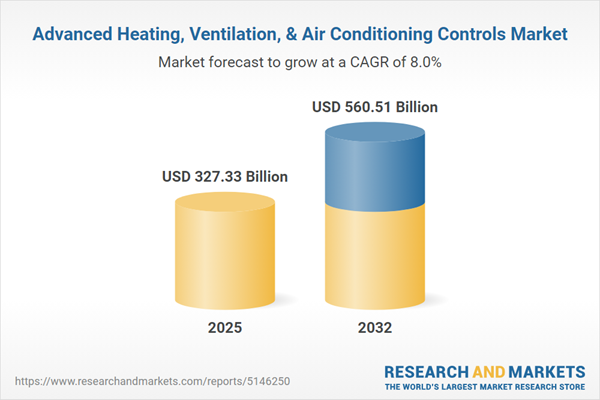Speak directly to the analyst to clarify any post sales queries you may have.
The Advanced HVAC Controls Market is redefining how organizations manage building performance. As operational pressures and sustainability standards intensify, senior leaders increasingly prioritize adaptive control, energy optimization, and digital automation to secure long-term success.
Market Snapshot: Advanced HVAC Controls Market Size & Growth Outlook
The Advanced HVAC Controls Market is poised for expansion, with a projected increase from USD 303.30 billion in 2024 to USD 327.33 billion by 2025, and further growth anticipated to USD 560.51 billion by 2032. This upward trajectory is underpinned by a CAGR of 7.97%, as organizations across sectors focus on deploying advanced tools and replacing legacy HVAC infrastructure. Investments in integrated control and automation are reshaping modernization strategies, driving adoption of solutions that enhance system visibility and efficiency while fostering regulatory alignment and strategic growth.
Scope & Segmentation of the Advanced HVAC Controls Market
- Offering Types: Hardware solutions, including actuators, sensors, and controllers, deliver precise real-time system feedback and enable granular operational oversight. Software platforms leverage collected data to generate actionable insights, advance energy management, and streamline collaboration across facility teams. Service offerings, such as consulting and maintenance, optimize operational efficiency and maximize lifecycle value of HVAC assets.
- Sales Channels: Direct sales cater to organizations with specialized facility needs that require tailored support, while distribution channels broaden market accessibility for multiple industries. Online procurement introduces flexibility and supports scalable, subscription-based engagement for accelerated deployment.
- End Use Sectors: Commercial users focus on comfort and reliability in workspaces, retail, hospitality, and healthcare. Industrial buyers emphasize operational consistency and regulatory compliance. The residential market prioritizes ease of use and demonstrable energy savings.
- Applications: Advanced controls support HVAC components, from chillers and boilers to heat pumps and ventilation units, making them essential for both retrofitting legacy buildings and enabling integration in new developments with smart management capabilities.
- Regional Coverage: The market spans North America, Europe, the Middle East and Africa, and Asia-Pacific. Adoption rates are shaped by regional regulations, infrastructure modernization programs, and the pace of digital transformation. Major economies, including the US, China, Germany, India, Japan, and Australia, influence broader technology uptake.
- Company Analysis: Leading companies such as Johnson Controls International, Siemens, Honeywell, Schneider Electric, ABB, Carrier Global, Trane Technologies, Emerson Electric, Delta Electronics, and Acuity Brands regularly enhance their offerings to meet client needs as competitive and regulatory conditions shift.
Key Takeaways: Strategic Insights for Senior Decision-Makers
- AI-powered control systems allow buildings to respond intelligently to occupant patterns and changing conditions, optimizing system performance and comfort.
- Architectures designed for easy integration facilitate retrofits and upgrades, reducing operational interruptions and controlling modernization costs for complex facilities.
- Predictive monitoring—through smart sensors and analytics—supports proactive maintenance and strengthens asset reliability, reducing unscheduled downtime.
- Industry-tailored service models address regulatory and technical considerations, supporting compliance and efficient facility operation across different sectors.
- Collaborative approaches between solution providers and on-site teams drive ongoing improvements and strategic alignment with evolving organizational goals.
- Responsive regulatory strategies enable businesses to adjust quickly to compliance changes, maintaining operational readiness while minimizing risk exposure.
Tariff Impact: Navigating 2025 US Trade Measures
Recent US trade policy adjustments are shaping procurement and supply chain strategies for HVAC controls. Market participants are prioritizing regional partnerships, resilient sourcing networks, and modular product architectures to maintain flexibility. Transparent supplier relationships and robust after-sales support are now key to navigating regulatory shifts and ensuring consistent operations in a changing environment.
Methodology & Data Sources
This report synthesizes insights from interviews with facility managers, system integrators, and strategic suppliers, enhanced by global surveys and regulatory reviews. In-depth industry research and financial documentation were used to validate findings, ensuring decision-makers have precise, actionable intelligence.
Why This Report Matters
- Segmented analysis and geographic insights empower leaders to focus resources on pivotal markets and high-growth opportunities.
- Regular monitoring of the regulatory and tariff landscape equips organizations to pre-empt disruption and maintain compliance across operating regions.
- Benchmarking enables identification of innovation areas, supporting informed partnerships and sustained competitiveness.
Conclusion
Senior executives gain data-driven clarity on trends and technology strategies in advanced HVAC controls. This intelligence streamlines decision-making, strengthens adaptability, and positions organizations for resilient performance as facilities and regulations evolve.
Additional Product Information:
- Purchase of this report includes 1 year online access with quarterly updates.
- This report can be updated on request. Please contact our Customer Experience team using the Ask a Question widget on our website.
Table of Contents
3. Executive Summary
4. Market Overview
7. Cumulative Impact of Artificial Intelligence 2025
Companies Mentioned
The companies profiled in this Advanced Heating, Ventilation, & Air Conditioning Controls market report include:- Johnson Controls International plc
- Siemens AG
- Honeywell International Inc.
- Schneider Electric SE
- ABB Ltd
- Carrier Global Corporation
- Trane Technologies plc
- Emerson Electric Co.
- Delta Electronics, Inc.
- Acuity Brands, Inc.
Table Information
| Report Attribute | Details |
|---|---|
| No. of Pages | 196 |
| Published | October 2025 |
| Forecast Period | 2025 - 2032 |
| Estimated Market Value ( USD | $ 327.33 Billion |
| Forecasted Market Value ( USD | $ 560.51 Billion |
| Compound Annual Growth Rate | 7.9% |
| Regions Covered | Global |
| No. of Companies Mentioned | 10 |









